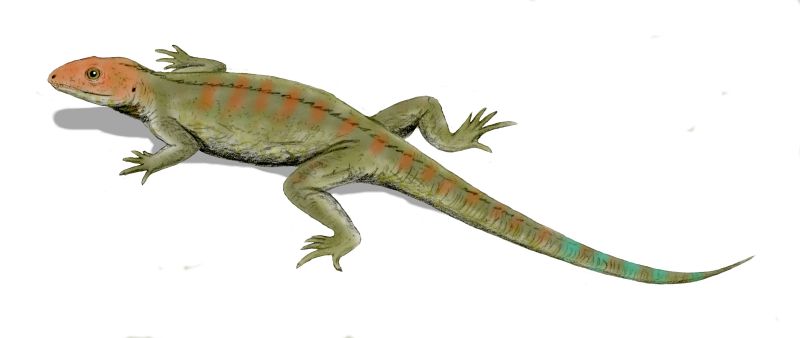- Hylonomus
Taxobox
name = "Hylonomus"
fossil_range =Early Pennsylvanian (LateCarboniferous )

image_caption = The primitivesauropsid , "Hylonomus lyelli"
image_width = 250px
regnum =Animal ia
phylum = Chordata
subphylum = Vertebrata
classis =Sauropsida
subclassis =Anapsida
ordo =Captorhinida
familia =Protorothyrididae
genus = "Hylonomus"
species = "H. lyelli"
binomial = "Hylonomus lyelli""Hylonomus" ("hylo-" "forest" + "nomos" "wanderer") [ [http://www.paleofile.com/Demo/Taxa/Hylonomus.htm Genus "Hylonomus" Etymology] ] was an early
reptile . It lived 315Ma (million years ago) during theCarboniferous period. As of 2006 it is the earliest confirmed reptile ("Westlothiana " is older but may be anamphibian ). It was 20 cm long (including the tail) and probably would have looked rather similar to modern lizards. It had small sharp teeth and probably ate small invertebrates, such asmillipede s or earlyinsect s. It is a precursor of later reptiles. Fossils of the basalpelycosaur "Archaeothyris " and the basaldiapsid "Petrolacosaurus " are also found in the same region of Nova Scotia.Fossils of "Hylonomus" have been found in the remains of fossilized tree stumps in
Joggins, Nova Scotia . It's thought that after harsh weather, the tree tops would crash down and the stumps became hollowed out due to rot. "Hylonomus" individuals seeking shelter would enter but get trapped, starving to death.Fossilized footprints found in
New Brunswick have been attributed to "Hylonomus". [* [http://news.bbc.co.uk/2/hi/science/nature/7047065.stm Ancient reptile tracks unearthed] - URL accessedOctober 22 ,2007 ]This animal was discovered by
Sir William Dawson in the 1800s. The name comes from the Greek word for wood, the Latin for mouse (forest mouse), and the name of the geologist, and Dawson's teacher,Sir Charles Lyell .References
External links
* [http://www.gov.ns.ca/legislature/HOUSE_OF_ASSEMBLY/Symbols/fossil.htm Nova Scotia provincial fossils] - Accessed
January 10 ,2008
* [http://museum.gov.ns.ca/fossils/sites/joggins/joggins2.htm Fossils of Nova Scotia - The Tree Stump Animals] - AccessedJanuary 10 ,2008
* [http://www.talkorigins.org/faqs/faq-transitional/part1b.html Transitional Vertebrate Fossils FAQ Part 1B] - AccessedJanuary 10 ,2008
* [http://www.jogginsfossilcliffs.net/cliffs/history/ Early Researchers & Finds of the Joggins Fossil Cliffs] - AccessedAugust 1 ,2008
* [http://web.archive.org/web/20071219181938/http://www.creda.net/~jfcliffs/science.htm The Science of the Joggins Fossil Cliffs] - AccessedAugust 2 2008
Wikimedia Foundation. 2010.
